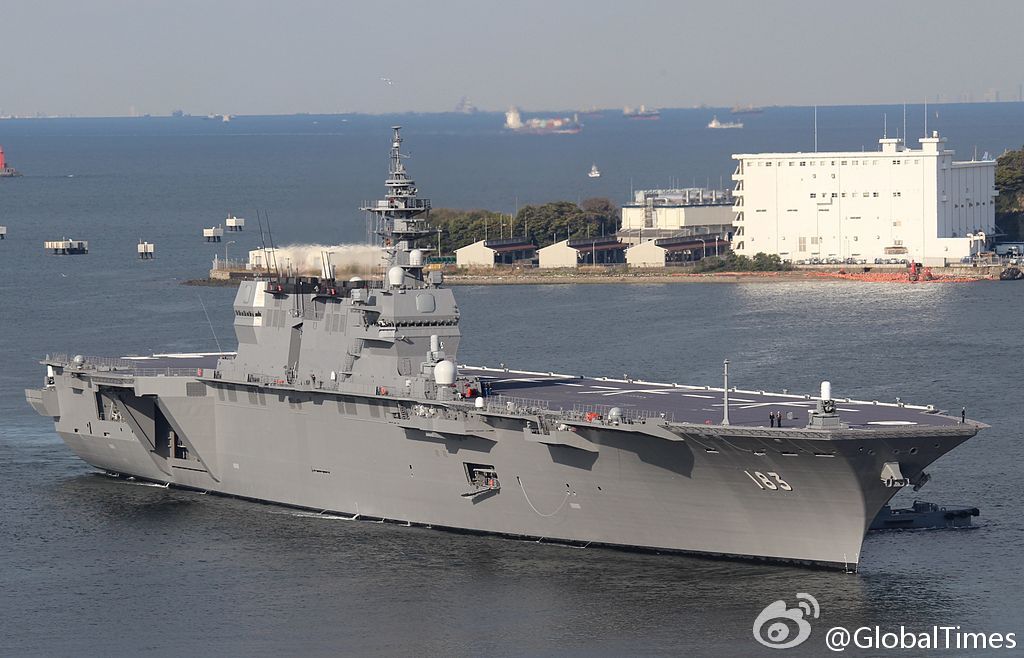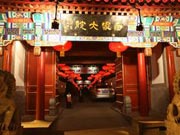

 |
| Japan's largest destroyer Izumo. (Photo/Global Times) |
Biggest warship since WWII could threaten China’s submarines: expert
Japan's Maritime Self Defense Force on Wednesday took delivery of its biggest warship since World War II, a vessel that observers say is a "de-facto aircraft carrier" and the latest sign that Prime Minister Shinzo Abe is actively seeking to loosen the restraints on Japan's pacifist constitution.
The 19,500-ton destroyer Izumo, measuring 248 meters long and 38 meters wide, allows five helicopters to take off and land simultaneously. It can also load MV-22 Osprey transport aircraft to be purchased by the Ground Self-Defense Force, Japan's Kyodo News reported.
Longer-range patrol aircraft and military cargo planes are also added to the Izumo's defense capability, aside from Japan's plan to buy Lockheed Martin F-35 fighter jets and amphibious assault vehicles from the US.
"The vessel can serve in a wide range of roles including peacekeeping operations, international disaster relief and aid," Gen Nakatani, Japan's Minister of Defense said standing beside the vessel after a handover ceremony at the Japan United Marine shipyard in Yokohama, Kanagawa Prefecture on Wednesday, Reuters reported.
"It also helps improve our ability to combat submarines," he said.
"Strategically speaking, one or two warships won't change the big picture. But from the perspective of military tactics, the Izumocan help increase Japan's anti-submarine capability and serve as the command ship for its navy's amphibious warfare," Zhang Junshe, a research fellow with the Navy Military Academic Research Institute under the People's Liberation Army, told the Global Times.
The large number of submarines is considered a strong point of the Chinese navy, according to Yin Zhuo, an admiral and senior researcher at the navy's Equipment Research Center, who considers the commissioning of the Izumoanother step from Japan to curb China, according to news portal people.com.cn.
With a crew of 470 sailors, the Izumoresembles US Marine Corps amphibious assault carriers in size and design but it is designated as a helicopter destroyer, a label that allows Japan to keep within the bounds of its constitutional ban on offensive weapons.
Aircraft carriers, due to their ability to project force, are considered offensive weapons, said Zhang.
However, military analysts have pointed out that the Izumo's barrier-free runway design and heat-resistant material will grant the destroyer the potential of being further upgraded into an aircraft carrier.
The Izumodoes not have a catapult necessary to launch fixed-wing fighters, but a planned vertical-take-off-and-landing variant of the F-35 could fly from the Izumo's flight deck.
Zhang said that being able to load F-35 fighter jets is a crucial sign that the destroyer could serve as Japan's "de-facto aircraft carrier."
"The Izumoproves that Japan has the technical capabilities and demand to develop aircraft carriers. It's also possible that Japan may explore the possibility during the Izumo's service," Li Jie, a Beijing-based military expert, told the Global Times.
Analysts have also said that warships like the Izumocan increase Japan's combat advantage in battles over small islands.
"A most straightforward example is that the Izumo, loaded with MV-22 Osprey transport aircraft, is cabable of delivering more than 200 fully-armed combat soldiers onto a certain remote island at once. Commissioning the Izumocould cast an influence on any potential maritime confrontation between China and Japan," Li noted.
Relations between China and Japan have been strained over the past few years over territorial disputes over the Diaoyu Islands in the East China Sea and Japan's reluctance to face its wartime aggression.
Abe has made a number of appeals to Japanese lawmakers, the latest in a February speech to Parliament, asking for the removal of provisions in the pacifist constitution that limits Japan's military to a self-defense role.
In January, the Japanese government announced a record military budget, with defense spending up more than 5 percent.
In a meeting with Liberal Democratic Party members on Tuesday, Abe allegedly said that China's military growth has exceeded his expectation and that Japan must not admit defeat and be fully prepared for necessary defense budget measures, Sankei Shimbun reported on Wednesday.
"We cannot yet say that Japan has taken a militarized path. However, 70 years after the war, it is at an important crossroads where militarization has presented itself as an option," Geng Xin, deputy director of Tokyo-based think tank New Japanese Institute of JCC, told the Global Times.
Another Japanese armored cruiser from the Imperial Japanese Navy also carried the name Izumo.
The cruiser, which participated in the invasion of China during WWII, was sunk by US air attacks on July 24, 1945.
Day|Week

 Tsinghua junior makes over 10,000 yuan a day by selling alumnae's used quilts
Tsinghua junior makes over 10,000 yuan a day by selling alumnae's used quilts Graduation photos of students from Zhongnan University
Graduation photos of students from Zhongnan University A school with only one teacher in deep mountains
A school with only one teacher in deep mountains Glimpse of cultural heritage "Xilankapu"
Glimpse of cultural heritage "Xilankapu" Homemade cured hams in SW China
Homemade cured hams in SW China Breathtaking buildings of W. Sichuan Plateau
Breathtaking buildings of W. Sichuan Plateau Graduation photos of "legal beauties"
Graduation photos of "legal beauties" Top 10 most expensive restaurants in Beijing in 2015
Top 10 most expensive restaurants in Beijing in 2015